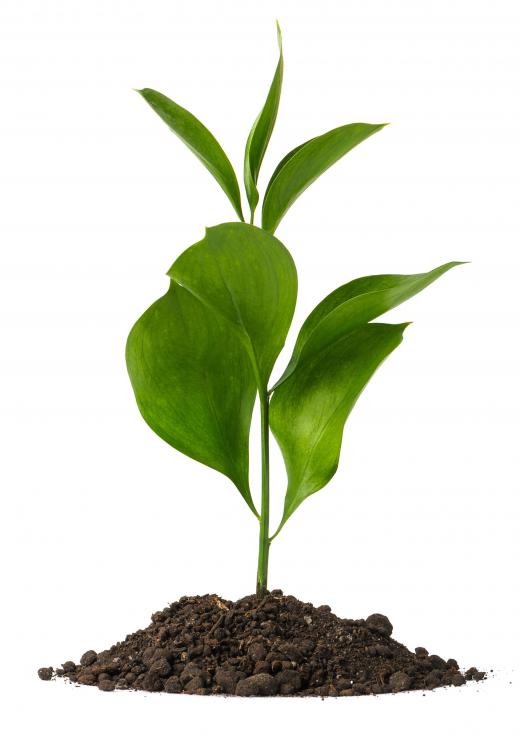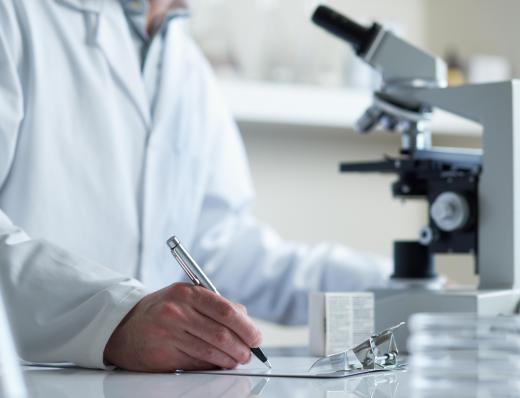What is Plant Anatomy?
 Mary McMahon
Mary McMahon
Plant anatomy is the study of the physical structure of plants. It is also known as phytoanatomy, with a practitioner of this scientific discipline being known as a phytoanatomist. As with animal anatomy, the goal is to learn more about how organisms are put together and how they work, with this information being used to obtain a deeper knowledge of how to care for plants and how to address diseases that affect them. Phytoanatomists work in a number of settings, including natural history museums, arboretums, and laboratories that develop new plants for agriculture and landscaping.
Phytoanatomists both study the structure of plants as a whole and dissect them to learn about their component parts. It can also take place on the microscopic level, with the anatomist examining plant cells to learn more about their function, and to differentiate between the various kinds of plant cells. Plant anatomists are also interested in the development of plants, from their earliest stages as seeds through their maturity into adulthood.

By dissecting and studying plants, researchers can learn about the differences between various plants, which is an important part of plant taxonomy. Two plants may look very similar on the surface, for example, but be radically different when they are dissected and viewed under the microscope. These differences can be used to describe and categorize the plants so that they can be placed within a taxonomic system. Plant anatomy can also involve carefully studying newly discovered plants to confirm that they are unique and to gather data about them that can be used to categorize them.

Increasingly, people are separating plant anatomy and morphology, with anatomy being concerned with the internal structure of plants, while morphology involves the exterior appearance of a plant. There are some overlaps between the fields, however. A flower, for example, can be examined by a morphologist and an anatomist, with both being interested in the exterior and internal structures of the flower to learn more about it.

People who work as plant anatomists usually take college courses in botany, biology, and related topics. They may choose to focus on specific types of plants, such as tropical plants, food crops, and so forth, or they may work as general anatomists in facilities like natural history museums, cataloging new acquisitions and managing existing collections so that they can be easily navigated and used as a resource by visitors. They can also work in sites like pharmaceutical research labs, studying plants with medicinal properties.
AS FEATURED ON:
AS FEATURED ON:














Discussion Comments
If you are taking any kind of plant course that doesn't involve actually dissecting the plants, you can always do your own home dissections.
There are few places in the world where you can't get access to roadside weeds, or the leaves and buds and flowers of trees, so you have plenty of variety of plants around you to choose from.
@Iluviaporos - While I think it's a good idea to practice plant anatomy by looking at the real thing, personally I prefer to have a really good diagram when I'm memorizing parts.
There are some excellent sites online if you look for them that teach science and they have different functions like flash cards to help you memorize.
I mean, let's face it, most people aren't going to be into dissecting plants when they don't have to. They just want to learn enough to pass the course. And an anatomy diagram will be plenty for them.
@irontoenail - If you are taking any kind of plant course that doesn't involve actually dissecting the plants, you can always do your own home dissections.
There are few places in the world where you can't get access to roadside weeds, or the leaves and buds and flowers of trees, so you have plenty of variety of plants around you to choose from.
And if all else fails, you can always get cheap plants at a gardening store or at a supermarket.
I agree that hands on is the best way to learn and there's no reason anyone should only learn this kind of thing from books.
Just use a really sharp kitchen knife if you don't have a scalpel and follow instructions if you aren't sure what to do.
Be careful though, it's easy to slip and cut yourself when you're trying to do minute work like that.
There is a wonderful plant anatomy course at my local university which is run as a summer paper and involves a very intense two weeks worth of study.
I haven't had a chance to do it myself, but from what I've read the students are taken out into the forest and every day they collect samples of local plants which they then categorize and dissect in the lab.
This way, they learn all about the local ecology and how to identify different plants as well as what the plants are used for, with a very hands on component.
It's tough to get into this course, because it's so popular and they only take about 20 students per year, but I really think this is the best way of teaching plant anatomy. I hope I can manage to get in this year.
Post your comments